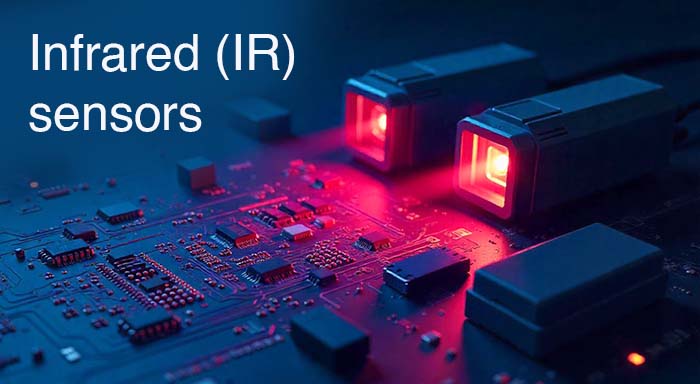Infrared (IR) sensors are indispensable parts of modern technology and have a whole assortment of applications spanning multiple industries. IR sensors add to the security of systems and smart home functionalities.
In this blog, we dig into the fundamentals of IR sensors and their working principles along with a wide variety of applications that will be of great help to professionals and hobbyists alike.
What are Infrared (IR) Sensors?
Infrared sensors are devices that detect and measure infrared radiation emitted or reflected by the object. Electromagnetic radiation of infrared radiation is longer than that of visible light that is not visible to the naked eye. Different IR sensors can detect temperature, movement, the presence of objects, and all utilities in varied aspects.
Working Principle Of An IR Sensor
An optical detector for IR sensors operates by sensing infrared radiation. Usually, such devices include an infrared emitter, which emits infrared light, and a detector which detects reflected infrared radiation for analysis of variations. Infrared radiation changes indicate changes in object position, distance, or temperature. These signals are processed electrically by the sensor to make measurements or to trigger responses.
Types of Infrared Sensors
1. Passive Infrared Sensors (PIR):
Infrared radiation from the environment is detected by these sensors. Motion detection applications are very popular, which can be seen in automatic lighting systems and security alarms.
2. Active Infrared Sensors:
Both these IoT sensors are based on an infrared light source along with a receiver. Objects they sense emit light that reflects on and back to the sensor, so they can detect distance, speed, and presence. It has found applications in proximity sensors and object count systems.
3. Infrared Thermometers:
These sensors take a sense of temperature by detecting the infrared radiation that an object emits. In industries where the temperature has to be monitored temperatures foods, healthcare, and manufacturing are a few examples of industries where temperature monitoring is essential.
Applications of Infrared Sensors
1. Security Systems:
Modern security solutions utilize IR sensors. They sense movement and sound the alarm or call the surveillance cameras. Military use of these applications is also extended, wherein they are used in night vision equipment.
2. Home Automation:
IR sensors are used in smart homes to offer energy efficiency as well as convenience. They are capable of automating systems that control the lighting, climate control, and security (but only if someone is there) in response to the presence or absence of occupants.
3. Industrial Applications:
The change in movement and heat is monitored by IR sensors to detect changes in manufacturing processes. It is the maintenance of the safety protocols and ensures equipment efficiency.
4. Healthcare:
In hospitals, infrared thermometers give you safe, non-contact temperature readings needed for patient care. IR sensors also allow for further sophisticated diagnostic tools such as thermography.
5. Environmental Monitoring:
Environmental parameters include gas concentrations and pollution levels that are measured by IR sensors. Ecological studies and pollution control require them.
Benefits of Infrared Sensors
Non-Contact Detection:
IR sensors can measure as well as detect without physical contact and are favored for hygiene or safety-sensitive applications.
Versatility:
IR sensors are ubiquitous with various adaptors applicable to different industries.
Energy Efficiency:
More important is the energy savings that IR sensors provide, especially in lighting and climate control applications, by operating only when needed.
Reliability:
For applications that require precision, being accurate and consistent, they have reasonable performance.
Conclusion
Infrared sensors find plenty of applications and continue to develop in the role of revolutionizers. Their impact is still significant whether it is improving security systems, improving industrial processes, or making home automation more modern.
These sensors are those that can make a world of difference in current applications and future innovations if only we can understand them. With all things progressing in the direction of becoming techy, you can be sure IR sensors will be an important part of forming smarter and more responsive environments.
FAQs For Infrared Sensors
1. What are the main components of an IR sensor?
Generally, IR sensors are made up of an emitter (infrared light source), and a detector (the receiver). Together during working these students identify infrared radiation emitted or reflected by objects.
2. Can IR sensors work in complete darkness?
Yes, IR sensors can function in complete darkness because they rely on detecting infrared radiation, which does not require visible light.
3. How are IR sensors used in smartphones?
IR sensors in smartphones are often employed for facial recognition, proximity sensing (e.g., turning off the screen during calls), and remote control functionalities for TVs and other devices.
4. Do IR sensors pose any health risks?
IR sensors are generally safe to use. They emit low levels of infrared radiation, which is non-ionizing and does not pose significant health risks with standard usage.



